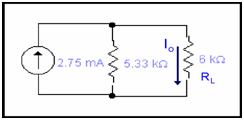Q: Determine the current Io by using Norton's theorem.

Solution:
We have to calculate I0 using Norton's theorem.
Step 1: Replacing RL along with a short circuit to discover IN. Here RL is equal to 6k resistor.

Step 2: Determine current IN

Through loop 2, we may write
I2=2mA
For path 1
4k(I1-IN)+2k(I1-I2)-6=0
4kI1-4kIN+2kI1-2kI2-6=0
6kI1-4kIN-2kI2=6
Putting the value of I2 from above eq.
6kI1-4kIN-2k(2m) = 6
6kI1-4kIN = 10
At Loop 3
4k (IN-I2) +4k (IN-I1) =0
4kIN-4kI2+4kIN-4kI1=0
-4kI1+8kIN=8
Solving out equations for loops 1 & 3
12kI1-8kIN=20
-12kI1+24kIN=24
16kIN=44
IN = 444/16 =2.75 mA
Step 3: Determining RN
To determine RN we have to short circuit all voltage sources & open the current sources.

For RN
2kII4k+4k =((2kx4k)/(2k+4k))+4k
RN = 5.33kΩ
Step 4:
After determining IN & RN, re-inserting the load resistance RL in the circuit in parallel RN and letting the IN current source parallel along these two resistances.

Io= (2.75m) (5.33k)x1/(6+5.33)k)
Io =1.29mA